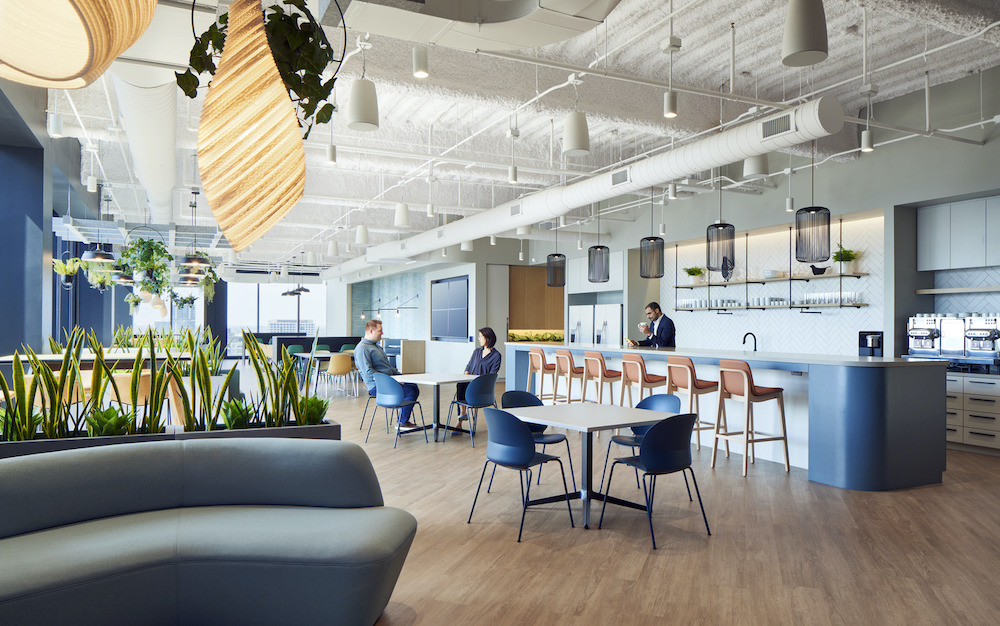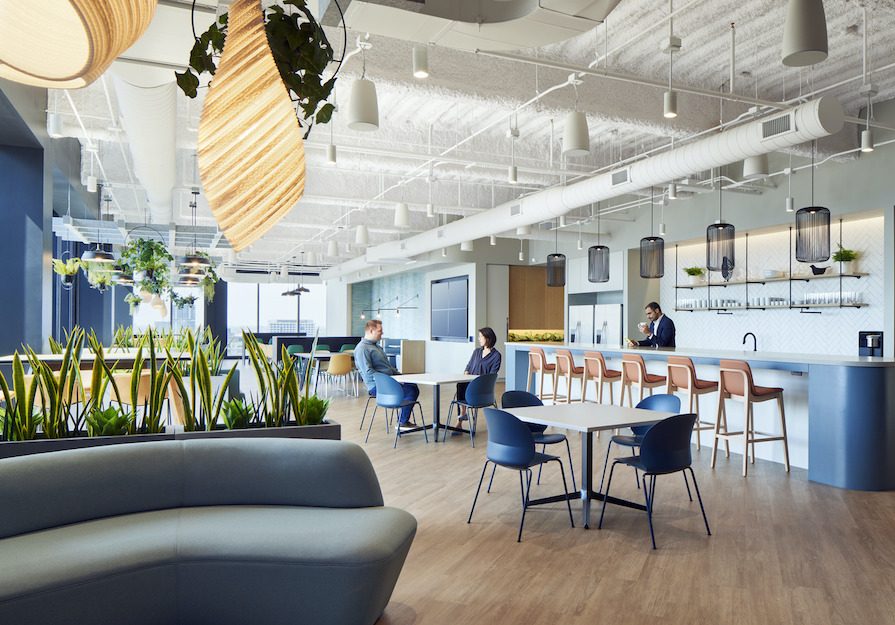In these fast-changing times, Albert De Plazaola of Unispace shares eight steps to defining the work change your teams need to thrive.

Prior to 2020, organizations would bring me into their “All Hands” session to share the (sometimes elusive) benefits of an open office. Private offices were repurposed as collaborative spaces, and dedicated workstations were converted into team spaces where employees could choose where they work. When this concept was translated into a thoughtful design, it worked. When translated as a thinly disguised excuse to generate space efficiencies, it was met by resistance and pushback, and with good reason.
Any change in one’s daily work habits is typically met with suspicion. Anger, denial and fear are all healthy responses to change. After all, these emotions stem from evolutionary reflexes that have helped us survive when resources were scarce and change really was a bad thing. Our reactions to new return to office programs are natural. You can’t blame people for the way they feel.
Change practitioners often use metaphors like “burning platform” to explain the necessity of change despite the fear of unknown consequences. The reality is if your business is failing, a new hybrid solution will not save it.
The reality is if your business is failing, a new hybrid solution will not save it.
Covid-19, was not just a burning platform, it was a bonfire. In fact, it was a thermonuclear bonfire that changed the way we work in a matter of weeks.
Let’s put it into perspective. The Wall Street Journal recently reported that prior to the pandemic, 5% of employees with advanced degrees worked remotely. By May 2020, that number shot up to nearly 70%.
The shift to open office was primarily a top-down measure, driven by leadership. Now, employees are driving change and defining the terms of their own work experiences –It’s no longer a binary discussion. It’s a change management and design opportunity.
Interestingly, most organizations are good at explaining why they are making cautious steps to draw people back into the office. Where they stumble is demonstrating empathy or addressing the emotional response to the suggested program.
Lack of empathy in organizations is fundamentally a design problem.
Narcissism, politics, conflicting agendas, siloed thinking, and self-interest can all prevent real conversations around change, even in the most transparent organizations. Lack of empathy in organizations is, fundamentally, a design problem.
Lack of empathy in organizations is fundamentally a design problem.
This lack of feeling has become more than just an HR headache. Research shows companies not prioritizing their people’s needs are losing out on up to 70% of jobseekers, hurting their competitive advantage in the war for talent.
So, how can corporate leaders balance attraction and retention against a vision for the business and real estate overhead expenses? By seizing the reins on workplace strategy to define change needs that will best serve your unique workforce. Our workplace teams have been recommending organizations ask employees what they want in a new workplace, as well as seek feedback on their past and present experiences.
By actively listening to your team’s desires and insights, companies can prove employee input is valued, helping to rally spirits, inspire engagement and drive retention. What’s more, active listening enables you to define the work change you know will directly support both your people, and your business—something even the best guesswork can’t do.
Eight steps to defining the work change your teams need
Every organization will have its own unique vision of work change, but to succeed, that vision must reflect the desired experiences of employees. First and foremost, take time to discover what your teams want from their work experience, and match those needs with business objectives.
Following are key steps to identifying the changes your workforce needs:
1. Envision your desired work culture.
Meaningful change always begins with a strong vision. To visualize your optimal work culture, explore questions about how organizational culture can come alive in design.
For example, how do people currently interact with their workspaces, and with each other—and what future state would better serve organizational goals? How can the hub office better facilitate people’s unique contributions? How can virtual collaboration tools affect community, and how can you harness them in a way that feeds, not drains, collaboration?
As you ruminate, consider creative ways to help your firm’s values come to life wherever, and however, your teams work.
2. Commit to an experiential and inclusive design approach.
In these disruptive times, change must be a journey, not a destination. Curate the journey with a multi-disciplinary approach that incorporates different perspectives and ideas, while acknowledging opportunities and obstacles.
Communicate with people across the workforce early and often in the process to gauge their thoughts on prospective change, and help earn adoption once change is implemented.
3. Consider the full picture of your desired end state.
In this newly hybrid-powered world, work change isn’t just about reimagining the hub office. For most companies, the future office will be part of a larger ecosystem comprised home offices, coffee shops, public transit, satellite offices, coworking spaces, and even augmented and virtual reality (VR) platforms.
Bring fresh ideas across the ecosystem to ensure a responsive model that gives employees the flexibility, culture and work-life balance they crave—while getting the most out of your real estate and technology expenses.
4. Start segmenting your business structure and workforce to understand who you need to talk to and collect data from.
Different people want different things from their work experience. They also need different tools and resources to learn new skills or overcome barriers. These considerations are influenced by variations ranging from people’s roles and work styles to their personalities and life experiences.
Invite all perspectives on the work experience. From there, take a page from retail firms and prepare detailed profiles to understand specific preferences your diverse employees have for their work experience.
5. Identify the data you already have, like surveys that you can leverage throughout the process.
Fresh input will be key moving forward, but begin with insights you already have access to. For example, what do you already know about what your teams need to succeed? Have you conducted ethnographic observations of behavior across space types to see hidden patterns? Have you collected pertinent information from badge data, beacon desk sensors, Wi-Fi logins, QR codes, or room reservation data to understand how people utilize current space?
Use any recent insights to help inform new outreach efforts, including curated and engaging focus groups, visioning sessions, and self-feedback boards, well as digital solutions like personalized online surveys.
6. Understand the appetite for flex/hybrid work.
Not everyone’s work-from-home experience looks the same—some thrived, some did not. The notion of returning to the anchor office may be more or less attractive depending on who’s talking.
For example, people with kids and/or aging relatives at home may have trouble trading newly won flexibility for a long commute ending in a lackluster office. Meanwhile, people who live alone may have been itching to come back to the office, but frustrated by not knowing who they’ll see there, or when.
Recognize how these diverging experiences will shape what different members of the same team may want from the future.
7. Remember not to go backwards.
Your employees have proven they can work flexibly, so stay competitive by taking the best of the past while looking towards the future.
For example, endless Zoom or Microsoft Teams calls may have led to meeting fatigue, not to mention lower engagement and participation rates. Instead of banishing virtual calls and forcing in-person-only meetings, use tech to get people’s feedback on how they’d like to incorporate a mix of both.
8. Start defining technology needs.
A dynamic hybrid experience demands an examination of your technology requirements. Don’t plan for the current state; imagine a future where collaborative technologies could make virtual interactions just as effective as face-to-face meetings.
Change minds, not just space, by defining an ecosystem
By actively listening to and prioritizing real people’s needs, organizations can discover—and bring to life—a rich work ecosystem where all employees thrive. Like all change, workplace transformation may be inevitable; but how we choose to shape it is up to us. Center your planning process around your people, and you’ll not only discover what needs to change—you’ll foster a happier, more productive workforce, too.


